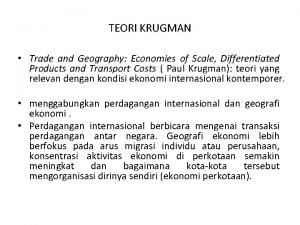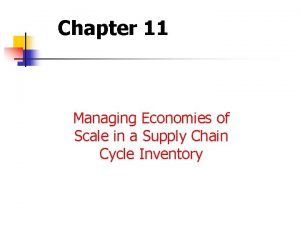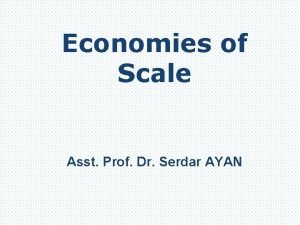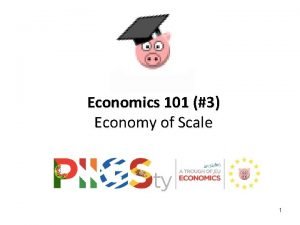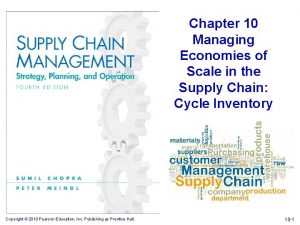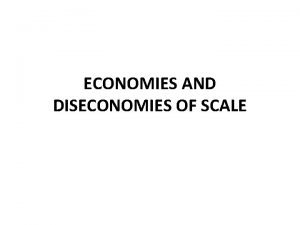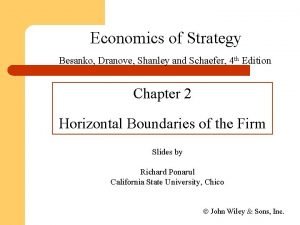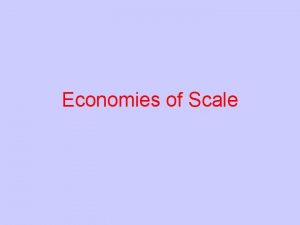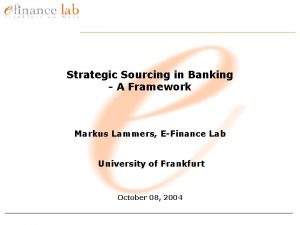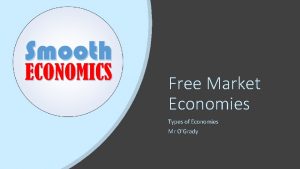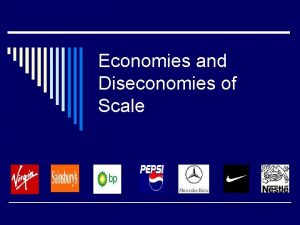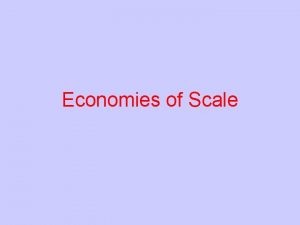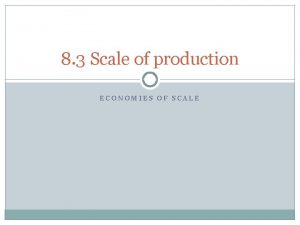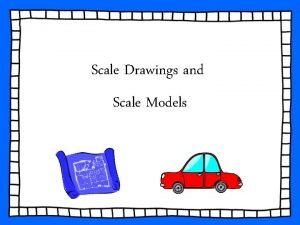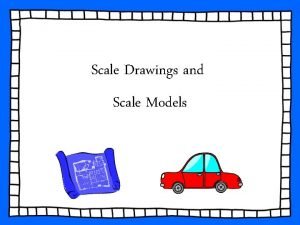Economies of Scale Mr OGrady Economies of Scale











- Slides: 11

Economies of Scale Mr O’Grady

Economies of Scale (Eo. S): where average costs fall as output rises Two types: Internal & External Internal Eo. S: Falls in average cost that arise from the growth of the business itself Increase in the firm’s output causes the firm’s average costs to fall Movement along the LRAC curve External Eo. S: Falls in average cost that arise from the growth of an industry Increase in the industry’s output causes each individual firm’s average costs to fall Shift downwards of the LRAC curve Cost A LRAC 1 B LRAC 2 Quantity

Types of Internal Eo. S Bulk purchase discounts: Reduced costs for larger businesses in buying inputs, such as raw materials and parts because of a larger discount given to a larger purchase than smaller businesses can make Example: Supermarkets get low prices when buying foodstuffs from farmers Marketing economies: A large firm can spread its advertising and marketing budget over a large output, lowering the marketing cost per unit. Example: A £ 1 million advertising campaign spread over 100, 000 units represents a lower unit cost than a £ 100, 000 campaign spread over 5000 units Managerial economies: This is a form of division of labour. Large-scale manufacturers employ specialists to supervise production systems, manage marketing systems and oversee human resources. Example: a large multi-national can employ one set of financial accountants for all its separate businesses. Financial economies: Larger firms are usually rated by the financial markets to be more 'credit worthy' and have access to credit facilities, with favourable rates of borrowing. In contrast, smaller firms often face higher rates of interest on overdrafts and loans. Technical economies: Large-scale businesses can afford to invest in expensive and specialist capital machinery. Example: Amazon can invest in technology that improves stock control, but it might not be viable or costefficient for a small shop to buy this technology. Risk-bearing economies: Derived by large firms who can bear business risks more effectively than smaller firms. Example: a large record company can more easily bear the risk of a ‘flop’ than a smaller record label.

Types of External Eo. S Infrastructure economies: occur as more infrastructure is put in place to benefit a specific industry. When many firms of the same industry are located in close proximity, the government will usually expand adapt public infrastructure in those areas to meet their needs (agglomeration effects). More roads and other transport infrastructure may be built, cutting transport costs Local colleges may provide training courses geared to the needs of that industry, lowers training costs & higher labour productivity Specialisation economies: when suppliers and workers start to focus on a particular industry due to its size. As the industry grows, it becomes more profitable for suppliers to focus exclusively on that industry, reducing suppliers’ costs as they specialise and leverage internal economies of scale. Similarly, it becomes easier for specialized workers to find a job in their field because the availability of jobs in the industry rises as well, reducing labour costs. Innovation economies: as industries become increasingly significant more innovation can take place. This is because their impact on society grows into a matter of public interest. This allows them to collaborate with universities and other research facilities to improve their products and processes while simultaneously reducing their own research expenses. Lobbying economies: As industries become more significant, they see an increase in bargaining power. That means most governments will be ready to compromise because they want to keep large industries in the area. Firm’s will negotiate favourable terms to cut costs (e. g. lower taxes, more subsidies)

Diseconomies of Scale Economies of Scale Mr O’Grady

Diseconomies of Scale (Do. S): where average costs rise as output rises Two types: Internal & External Internal Do. S: Increases in AC arising from the growth of the business itself Increase in the firm’s output causes the firm’s average costs to rise Movement along the LRAC curve External Eo. S: Increases in average cost that arise from the growth of an industry Increase in the industry’s output causes each individual firm’s average costs to rise Shift downwards of the LRAC curve Cost LRAC 2 B LRAC 1 A Quantity

Types of Internal Do. S Poor Communication: Large firms find it difficult to maintain an effective flow of information between departments, divisions or between head office and subsidiaries. Time lags in the flow of information can also create problems in terms of the speed of response to changing market conditions. Example: a large supermarket chain may be less responsive to changing tastes and fashions than a much smaller ‘local’ retailer. Co-ordination problems: also affect large firms with many departments and divisions, and may find it much harder to co-ordinate its operations than a smaller firm. Example: a small manufacturer can more easily co-ordinate the activities of its small number of staff than a large manufacturer employing tens of thousands. ‘X’ inefficiency: When a firm is suitably large and making healthy profits, it lacks incentive to try to control costs. It moves along the LRAC curve , from one SRAC curve to a higher cost one. Low motivation: Workers may feel unvalued and unmotivated in a large firm, their productivity may then drop. Large firms may also experience inefficiencies related to the principal-agent problem. Principal agent problem: where the size and complexity of most large firms means that their owners have to delegate decision making to appointed managers, which can lead to suboptimal decisions. Example: the owners of a large chain of clothes retailers will have to employ managers for each store. One job the managers have is to hire staff. They may not necessarily choose the best candidates from the point of view of the owners. They may employ their friends or the most attractive candidates rather than the most productive.

Types of External Do. S Competition for scarce resources: As an industry grows, total demand for resources from all firms in that industry increases, driving up the prices of these resources and the costs to firms will rise at all output levels. Examples: More competition for skilled labourers pushes up wages (good for the workers though. A larger fur industry leads to higher fur prices (higher demand ever falling supply) which increases the cost of fur. Infrastructure diseconomies: If an industry grows rapidly it may overwhelm its surrounding infrastructure for instance roads may become overly congested. Example: Taxis/Uber in metropolitan areas. The growth of the taxi industry has greatly increases traffic in city streets that are very difficult to expand. This will increase journey time meaning that it will cost a firm more to complete a drive as they have to pay for more fuel and more labour.

Economies of Scope Economies of Scale Mr O’Grady

Economies of Scope: Where firms see a fall in costs due to producing an increased variety of products (not volume like economies of scale) They make product diversification less costly as firms are able to use certain assets, whether tangible or intangible to produce multiple different goods Advantages: Economies of scope have the following advantages for businesses: [1] Flexibility in switching production between different goods Reduced costs from less waste as resources are able to switch to different tasks Low inventory storage costs as firms can switch their resources away from products with temporarily lower demand A company that sells many product lines, sells in many countries, or both will benefit from reduced risk (e. g. , if a product line falls out of fashion or if one country has an economic slowdown, the company will likely be able to continue trading) However: Some economists dispute the relevance of economies of scope and argue that they should just be considered as a subset of economies of scale Arguably firms can only diversify once they are sufficiently large!

Where next? Visit our website: www. smootheconomics. co. uk Find more resources, enrichment materials, details of courses, competitions, and more! Find Our socials: You. Tube: Smooth Economics Instagram: @smootheconomics Twitter: @Smooth. Economics Facebook: @Smooth. Economics
 Faktor penyebab economies of scale
Faktor penyebab economies of scale Managing economies of scale in a supply chain
Managing economies of scale in a supply chain Managing economies of scale in a supply chain
Managing economies of scale in a supply chain Serdar ayan
Serdar ayan Economies of scale
Economies of scale Economies of scale supply chain
Economies of scale supply chain Economies of scale
Economies of scale Technical economies of scale
Technical economies of scale Cube square rule economies of scale
Cube square rule economies of scale Advantages and disadvantages of diseconomies of scale
Advantages and disadvantages of diseconomies of scale Economies of scale ap human geography
Economies of scale ap human geography Outsourcing defintion
Outsourcing defintion
